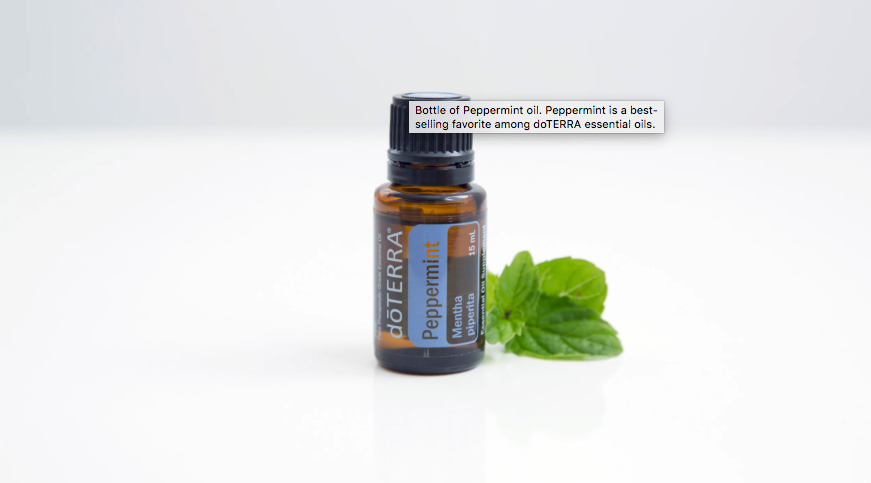The peppermint plant is a versatile perennial herb that has been cherished since ancient times. The plant’s first recorded appearance dates back to 1000 BC when dried peppermint leaves were found entombed in ancient Egyptian pyramids.1 Throughout human history, this herb has been valued as a multi-purpose plant and an essential oil whose components are now used by cosmetic, culinary, and health industries around the world. When you use it internally, Peppermint oil is also well known for its ability to help alleviate occasional upset stomach and promote healthy respiratory function.* With so many facets and uses, it is no surprise that Peppermint oil continues to be one of doTERRA’s best-selling and highly-favored essential oils. Where to Buy Peppermint OilTo buy a pure bottle of Peppermint, visit our Peppermint oil product page. Many essential oils available in the industry contain filler substances and contaminants that weaken the purity and power of the oil. However, at doTERRA, we know that a pure bottle of essential oil has the potential to change lives; that’s why doTERRA’s mission is to provide essential oils that are highly effective and free of additives and harmful contaminants. Our Peppermint oil is produced in the Pacific Northwest of the United States and other regions of the world. Through the partnership doTERRA has created with our growers, we receive only the highest quality Peppermint oil, which is then rigorously tested. We guarantee pure essential oils through the CPTG Certified Pure Therapeutic Grade® quality protocol. This protocol includes a series of strict tests that ensure the essentials oils we sell are free from filler substances or impurities—making the doTERRA essential oils you purchase powerful and pure. Peppermint Oil Uses and Benefits
Fun Fact Peppermint’s scientific name is Mentha piperita. In ancient Greek Mythology, Minthe (also known as Mentha), a nymph, was transformed by Queen Persephone into a sweet-smelling mint.2 Plant Description The peppermint plant is a hybrid of water mint and spearmint plants. This cooling and relaxing herb is characterized by its square stem, dark green leaves, and small bunches of light lavender flowers. The peppermint plant can grow to be approximately 18–36 inches tall and can be found in a variety of different areas. Peppermint is known to grow best by streams or in wet locations with a lot of rainfall. Due to its specific water needs, Peppermint is cultivated in Europe, Asia, and North America. Chemistry of Peppermint Oil Main Chemical Components: Menthol, Menthone, 1,8-Cineole The main chemical component in Peppermint oil is menthol. Menthol has a monoterpene backbone with an alcohol functional group. Menthol contains energizing properties that contribute to the overall energizing effect of Peppermint oil. Menthol is known to soothe the smooth muscle that lines the colon.* This relaxant property occurs due to menthol’s ability to keep calcium channels working optimally. The relaxing of colon smooth muscle reduces the movement of bowels, which eases occasional bowel looseness. Because of this effect, menthol is a main contributor to Peppermint essential oil’s ability to promote digestive health.* When Peppermint is swallowed, typically it is followed by a cooling sensation. This response happens because menthol activates the TRPM8 receptor, an indicator of cold.3* Caution Possible skin sensitivity. Keep out of reach of children. If you are pregnant, nursing, or under a doctor’s care, consult your physician. Avoid contact with eyes, inner ears, and sensitive areas. |
Essential Oil Spotlight
The peppermint plant is a hybrid of watermint and spearmint and was first described by Carl Linneaus in 1753. A high menthol content—like that found in the dōTERRA Peppermint essential oil—distinguishes the best quality Peppermint from other products. Frequently used in toothpaste and chewing gum for oral hygiene, Peppermint also helps alleviate occasional stomach upset and promotes healthy respiratory function when taken internally.* Peppermint continues to be one of the best- selling favorites among dōTERRA essential oils. USES
DIRECTIONS FOR USE Diffusion: Use three to four drops in the diffuser of choice.Internal use: Dilute one drop in 4 fl. oz. of liquid. Topical use: Apply one to two drops to desired area. Dilute with a carrier oil to minimize any skin sensitivity. See additional precautions below. CAUTIONS Possible skin sensitivity. Keep out of reach of children. If you are pregnant, nursing, or under a doctor’s care, consult your physician. Avoid contact with eyes, inner ears, and sensitive areas. *These statements have not been evaluated by the Food and Drug Administration. This product is not intended to diagnose, treat, cure, or prevent any disease.
|
Let us know about your experiences with this oil in the comments below.
